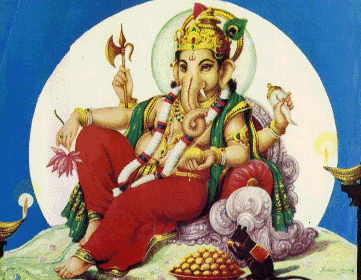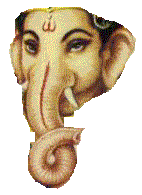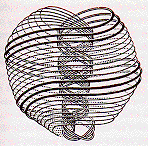
To distinguish between
and
the Virtual Fundamental Elementary Fermion Particles that make up the Sea of Virtual Fundamental Elementary Fermion Particles within the Vortex and one Real Valence Fundamental Elementary Fermion Particle at the Center of the Vortex,
Sidharth says:
"... a particle can indeed be treated as a vortex or a spherical shell of relativistic sub constituents ... Ganeshas ..."
According to The Myths and Gods of India, by Alain Danielou (Inner Traditions International, 1991, at pages 291-296):
"... [ A category is] ... a fundamental element of existence. All that can be counted or comprehended is a category (gana), the word category meaning any collection of things. The principle of all the classifications through which the relations between different orders of things, between the macrocosm and the microcosm, can be understood is called the Lord-of-Categories [or Ganapati, or Ganesha] .... [Ganesha] rules over the universal-Intellect and the principles-of-the-elements derived from it ... Ganapati [Ganesha] stands for ... the identity of the macrocosm and the microcosm ... [which] can be observed in the permanence of the relations found as the substratum of all the aspects of the perceptible universe. These relations can best be expressed in terms of number. Hence number is easily seen as the common element of all forms, the all-pervading unity of all substances. ... Ganapati [Ganesha] is represented as an elephant-headed man to express the unity of the small being, the microcosm ... and ... the macrocosm, pictured as an elephant [Gaja]. ... The trunk of Ganapati [Ganesha] is sometimes represented as bent to the right and sometimes to the left. ... These are the right-hand and the left-hand ways. This meaning applies also to the swastika ... The vehicle of Ganapati [Ganesha] is the mouse [Musaka] ... the master of the inside of everything ..."
Here is an image of Ganesha from The Hindu Universe:

To me, there is a striking resemblance between the Elephant-Gaja Head Aspect of Ganesha

and a Compton Radius Vortex

Also, the Mouse-Musaka Aspect of Ganesha

reminds me of the small-scale Valence and Virtual Fundamental Elementary Particles that make up a Compton Radius Vortex.
Therefore, I call
the Physical Compton Radius Vortex particles Gaja/Ganesha particles,
following the suggestion of Sidharth that the terminology for distinction should come from the Hindu God Ganesha who connects the Macrosphere-Elephant-Gaja with the Microsphere-Mouse-Musaka by using Mathematics.
and that Ganesha's 4 Human arms correspond to a Swastika that could represent a Wheel of Natural Law relating Macrocosm and Microcosm that can be expressed in Mathematics.
Ganesha's 4 Human arms could also correspond to Sarfatti 4-Mouth Structures of Compton Radius Vortices, Classical Black Holes, and Planck Pivot Vortices:
Indra, who lives in the binomial triangle Mt. Meru, is the principal god of the Rig-Veda of the Indus-Saravasvati.
According to a fall 1996 web page by Scott Taylor for a psychology class at Sonoma State University:"... The Net of Indra. The metaphor of Indra's Jeweled Net is Attributed to an ancient Buddhist named Tu-Shun (557-640 B.C.E.). ... Tu-Shun asks us to envision a vast net;
- at each juncture there lies a jewel;
- each jewel reflects all the other jewels in this cosmic matrix.
- Every jewel represents an individual life form, atom, cell or unit of consciousness.
- Each jewel, in turn, is intrinsically and intimately connected to all the others;
- thus, a change in one gem is reflected in all the others.
This last aspect of the jeweled net is explored in a question/answer dialog of teacher and student in the Avatamsaka sutra. In answer to the question: "how can all these jewels be considered one jewel?" it is replied: "If you don't believe that one jewel...is all the jewels...just put a dot on the jewel [in question]. When one jewel is dotted, there are dots on all the jewels...Since there are dots on all the jewels...We know that all the jewels are one jewel" ...".
Once upon a Time, Indra, as king of heaven, wanted to stop an event. Indra summoned Kali, an aspect of Shiva representing Time, who acted as Obstruction to stop the event. Obstruction then began to stop many other events. Only Ganesha, as Lord-of-Categories, was beyond Time, so Ganesha controlled Time and became Lord-of-Obstruction. Now, at the start of any undertaking, the help of Ganesha is needed to control Obstructions.
Shiva is the principal god of the Ganges, which became the dominant part of India after the Sarasvati River went dry. During a Maha Kumbh Mela, on 26 January 2001, a 7.9 magnitude Earthquake hit India at the mouth of the Indus-Sarasvati.
The following two aspects of Shiva can be compared to Egyptian Osiris:
According to Religions of India in Practice, chapter 45, Origins of Linga Worship, by Richard H. Davis (Department of Religious Studies, Yale University):"... Puranas (literally, "Old Traditions") ... The well-known narrative excerpted here, "The Origin of Linga Worship" ... focuses on a group of sages ... The ... sages saw Shiva and Vishnu fooling the women and sons, and were infuriated. Tricked by his appearance, they unleashed harsh words at Shiva ... The brahmans looked at the naked, mountain-dwelling, mutilated Shiva moving, and began to beat him with sticks, clods of dirt, and fists. They yelled at him , "You foul-minded one! Pull out your linga!" ... Shiva ... ripped it out. Immediately, Shiva, Vishnu, and the linga were no more to be seen.Then began strange portents, betokening danger to all the worlds.
- The sun with its thousand rays did not shine.
- The earth began to tremble.
- All the planets lost their splendor, and
- the ocean roiled. ...
... all the sages ... began to narrate the whole incident to the eminent Brahma. The sages said: "A certain person of extreme beauty came to our auspicious Pine Forest, stark naked, accompanied by his wife, beautiful in every limb. This lord beguiled our wives and daughters with his handsome figure, and his wife seduced our sons. We made various curses, but he repelled them. We beat him soundly, and his linga was thrown down. The lord, his wife, and the linga all disappeared. Then terrible portents began ...". ...
... lotus-born Brahma, the inner soul of the world, meditated on the trident-marked god Shiva, and spoke ... "What an error you have made! ... This god is the great god Shiva ... You were fooled by his power of appearance. You did not recognize the great god Shiva ... You should recognize him as Shiva ... You should make a copy of the god's linga which you saw fall to the ground ... and ... offer worship to that matchless linga ..." ...
... Then all the sages praised the great Shiva ... "I will tell you the secret ..." replied Shiva ... "Knowledge and yogic practice should be understood as a twofold method for man's attainment. ... the highest being is not seen through yoga alone, since only knowledge can give the fruit of final liberation. ... The soul is one, all-pervading, amounting to consciousness alone. ... This is the correct view, which is the highest knowledge. ...".
According to The Myths and Gods of India, by Alain Danielou:
"... Kali, the Power of Time ... is represented as a goddess, consort of the aspect of Shiva ... known as ... Maha-Kala ... Kali ... stands upon ... the corpse of the ruined universe. So long as the power that gives life to the universe remains predominant it is favorable (Shiva), but when it is without strength it becomes as a corpse (Shava). Hence it is said thatwithout i, symbol of ... power, the lord-of-life (Shiva) is a corpse (Shava). The lifeless body is indeed a symbol of whatever is left of the ... universe ... At the time of universal destruction, the Power of Time [goddess Kali], the power of destruction, is all that remains. It [goddess Kali] can well be represented as standing upon the debris of a universe in ruins, which lies powerless as a corpse [Shiva/Shava]. ...".
According to a page on the shivashakti web site: ".. Shiva ... without shakti ... has the form of a corpse, while when he is joined with the devi, he is Shivo-ham. ...". Another page on the shivashakti web site indicates that ham means the male part.
According to an Indiana web page: "... Kali ... dances on the corpse (shava) of Shiva. ... the "corpse" is represented with an erect male organ, or alternatively, with a cobra arising from the body. ...".
According to an urday.com web page: "... the plant of Rudraksha is originated from the tear drops of Lord Shiva. ... The botanical name of the Rudraksha plant is 'ELAEOCARPUS GRANITRUS'. ...

... [image from a himalayanacademy web page] ...
... This is found in the various parts of the world. "Rudraksha is formed by association of two words, 'RUDRA' and 'AKSHA" or AAKSHA". Rudra is the name of Lord Shiva. Aksha ...[means]... 'eye'. Aaksha means 'tear'. ... It is said that the seed of Rudraksha contains the secrets of entire evolution of the cosmos within it. ...
... To the devotees of lord Shiva, this is a very mystically potent seed in which the god has encoded the deep secrets of the existence. ...
... There are small holes on the top and at the bottom of the seed of Rudraksha. Deep grooves are formed running from the top of the seed to its bottom. These grooves are called the face of a Rudraksha seed. These vary considerably in number. ... Depending upon the number of faces in a Rudraksha, these seeds have special characteristics and powers. ...
- ONE FACED RUDRAKSHA This is the best among all other Rudraksha seed. This is the mother of all other forms of Rudraksha. ... On the Eights day of the month of Chaitra Shukla Paksha (as per hindu calendar) which falls around 27th of March every year, this Rudraksha is worshipped by offering 108 red coloured flowers. ...
- TWO FACED RUDRAKSHA Two faced Rudraksha signifies lord Rudra and his consort Parvati. ...
- THREE FACED RUDRAKSHA Three faced Rudraksha symbolises lord Agni - the fire god. ...
- FOUR-FACED RUDRAKSHA This symbolises lord Brahma. ...
- FIVE-FACED RUDRAKSHA All five Brahmas ...
- SIX FACED RUDRAKSHA This is regarded as the symbol of Kartikeya, the six faced son of lord Rudra and moher Sharada. He is the younger brother of lord Ganesha. ...
- SEVEN FACED RUDRAKSHS This Rudrakshs symbolises the seven great rishis [seers,or sages] ...
- EIGHT FACED RUDRAKSHA This Rudraksha is said to represent lord Ganesha ... The elephant headed benign god, the son of lord Shiva and Parvati ...
- NINE FACED RUDRAKSHA This Rudraksha jointly represents Bhairava yama (lord of death) and sage Kapila. ...
- TEN FACED RUDRAKSHA This Rudraksha represents lord Vishnu. ...
- ELEVEN FACED RUDRAKSHS This is the symbol of Indra, the lord of the gods. It has combined powers of eleven gods stored within. ...
- TWELVE FACED RUDRAKSHA This also symbolises lord Vishnu. ...
- THIRTEEN FACED RUDRAKSHA This Rudraksha signifies Vishvadevas. ...
- FOURTEEN FACED RUDRAKSHA This Rudraksha symbolises lord Shiva and also lord Hanuman. ...
Acccording to a page on the shivashakti web site: "... Malas (rosaries) are ... used to count the mantra recited to the devata installed in image or yantra. ... the classic Tantrika rosaries are made of ... rudraksha ... lotus seeds, skull bone/teeth ... The number of beads may be 27, 54 or 108 - but there is always an extra bead inserted - called the meru, so that one knows when the cycle is finished ... The beads should be scented with the eight great scents ...".
According to a tibet.com web page: "... means of telling the future were employed in Tibet, before the advent of Buddhism ... There are no references to divination in the collections of sutras, but many can be found in the tantras. ...
- Dice Divination: Palden Lhamo dice divination is conducted with three dice with a number from one to six indicated by dots on each face. ...[ 6x6x6 = 216 = 2x108 = 2x2x2 x 3x3x3 = 8 x 27 so that ancient Vedic cubic dice divination may be a combination of a binary system like I Ching and IFA and a ternary system like Tai Hsuan Ching and ternary structures like Triality, the 27-dimensional exceptional Jordan algebra J3(O), and the 27-dimensional MacroSpace of the D4-D5-E6-E7-E8 VoDou physics model. ]...
- Divination on a rosary: The person doing the divination prays to the deity he is invoking for the correct answer and recites that deity's mantras. He then holds up the rosary horizontally in front of him, with the fingers of each hand grasping a randomly chosen bead, leaving half the beads of fewer between them. Then the fingers of each hand move towards each other counting three beads at a time. The outcome of the divination depends on the number of beads left. The procedure is repeated three times. When only one bead remains, the result is called 'falcon'. When two beads remain, it is called 'raven'. When three beads remain the result is called 'snow lion'. ...".
It seems to me that ancient Vedic rosary/mala bead divination, using 27, 54 or 108 beads, counting three beads at a time, getting three outcomes, and repeating three the procedure three times, is a ternary system like Tai Hsuan Ching and the ternary structures: Triality; the 27-dimensional exceptional Jordan algebra J3(O); and the 27-dimensional MacroSpace of the D4-D5-E6-E7-E8 VoDou physics model.
It seems to me as though Vedic divination and Tai Hsuan Ching are based on the Triality aspect of the 256-dimensional Cl(8) Clifford algebra of IFA, while I Ching is based on the Yin-Yang-Binary-Duality aspect 64-dimensional Cl(6) Clifford subalgebra of the Cl(8) of IFA.
Ganesha is a son of Shiva and Parvati (the lady of the mountain). After Ganesha lost his head (perhaps cut off by Shiva when Shiva did not know that Ganesha was Parvati's son, perhaps by the evil deed of another god), Shiva replaced it with the head of an elephant (gaja).
References:
......